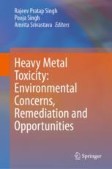Search
Search Results
-
Copper chelation suppresses epithelial-mesenchymal transition by inhibition of canonical and non-canonical TGF-β signaling pathways in cancer
BackgroundMetastatic cancer cells exploit Epithelial-mesenchymal-transition (EMT) to enhance their migration, invasion, and resistance to treatments....

-
An overview of heavy metals toxicity in plants, tolerance mechanism, and alleviation through lysine-chelation with micro-nutrients—A novel approach
AbstractPlants must adapt themselves to the prevailing conditions for their survival, resulting in the acquisition of a wide range of metal tolerance...

-
Metal Chelation as a Promising Strategy to Combat Fungal Drug Resistance
Among various human fungal diseases, candidiasis caused by Candida albicans is predominant in immunocompromised individuals. Widespread and...
-
Fe Chelation and Zinc Solubilization: A Promising Approach for Cereals Biofortification
Micronutrient deficiency, micronutrient malnutrition or hidden hunger is an increasingly severe global challenge for humankind. As wheat, rice and...
-
Design and synthesis of N-hydroxyalkyl substituted deferiprone: a kind of iron chelating agents for Parkinson's disease chelation therapy strategy
The blood–brain barrier (BBB) permeability of molecules needs to meet stringent requirements of Lipinski’s rule, which pose a difficulty for the...

-
Fluorescent Pseudomonads in Iron Chelation and Plant Growth Promotion in Abiotic Stresses
Iron is an essential nutrient for plant growth and plays a pivotal role in the energy metabolism of plants. But abiotic stress such as soil salinity...
-
Iron chelation by deferiprone does not rescue the Niemann-Pick Disease Type C1 mouse model
Niemann-Pick Disease Type C (NP-C) is a fatal lysosomal storage disorder with progressive neurodegeneration. In addition to the characteristic...

-
Characterization of metallothionein genes from Broussonetia papyrifera: metal binding and heavy metal tolerance mechanisms
BackgroundBroussonetia papyrifera is an economically significant tree with high utilization value, yet its cultivation is often constrained by soil...

-
Can iron chelators ameliorate viral infections?
The redox reactivity of iron is a double-edged sword for cell functions, being either essential or harmful depending on metal concentration and...

-
High throughput fluorimetric assessment of iron traffic and chelation in iron-overloaded Caenorhabditis elegans
The nematode Caenorhabditis elegans ( C. elegans ) is a convenient tool to evaluate iron metabolism as it shares great orthology with human proteins...

-
Optimization of citric acid treatment for the sequential extraction of fucoidan and alginate from Sargassum latifolium and their potential antioxidant and Fe(III) chelation properties
In this study, citric acid was applied as a safe organic acid for the treatment of the brown macroalga Sargassum latifolium to facilitate the...

-
The role of microbial partners in heavy metal metabolism in plants: a review
Heavy metal pollution threatens plant growth and development as well as ecological stability. Here, we synthesize current research on the interplay...

-
The chemical characteristics of different sodium iron ethylenediaminetetraacetate sources and their relative bioavailabilities for broilers fed with a conventional corn-soybean meal diet
BackgroundOur previous studies demonstrated that divalent organic iron (Fe) proteinate sources with higher complexation or chelation strengths as...

-
Iron mobilization from intact ferritin: effect of differential redox activity of quinone derivatives with NADH/O2 and in situ-generated ROS
Ferritins are multimeric nanocage proteins that sequester/concentrate excess of free iron and catalytically synthesize a hydrated ferric oxyhydroxide...

-
Expression of OsHARBI1-1 enhances the tolerance of Arabidopsis thaliana to cadmium
BackgroundAs one of the major food crops in the world, rice is vulnerable to cadmium (Cd) pollution. Understanding of the molecular mechanisms of Cd...

-
Copper and Cadmium Signaling in Plants Under Stressed and Non-stressed Conditions
Soil contamination by heavy metals is a prevalent environmental problem caused by factors like urbanization, industrial growth, agriculture, waste...
-
Determination of Chemical, Physical, and Functional Properties of ‘Karaerik’ Grape (Vitis vinifera L. cv. ‘Karaerik’)
This study aimed to investigate the effects of altitude and ripening stage on the total fat content and fatty acid composition, antioxidant...
-
Hydrazone-containing organotin(IV) complexes: synthesis, characterization, antimicrobial, antioxidant activity and molecular-docking studies
The diorganotin(IV) complexes ( 5–20 ) were synthesized in the present research from 4-fluorophenoxyacetic hydrazide and salicylaldehyde...

-
Minimization of Cadmium Toxicity in Wheat by Exogenous Application of Hydroxamate Siderophore
Siderophores are considered as small molecular weight, non-ribosomal peptides with high affinity for ferric ions. Recent studies confirmed its...
-
Cadmium toxicity: its’ uptake and retaliation by plant defence system and ja signaling
Cadmium (Cd +2 ) renders multifarious environmental stresses and highly toxic to nearly all living organisms including plants. Cd causes toxicity by...

